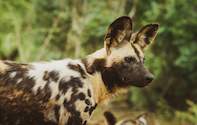
The seven wild dogs released into the Balule Private Nature Reserve in May last year have settled in well, producing two litters of pups. However, not all has been plain sailing, and some conflict has arisen along the way between the wild dogs and landowners in the area - a common problem in many wild dog reintroductions.
The conflict has led to negative remarks being made to those heading up the re-introduction, as well as the loss of the second litter of pups after they had to be relocated from the den they were born in. The wild dogs released into Balule came from Marakele National Park and Madikwe Private Nature Reserve under the supervision of the Wild Dog Advisory Group (Wag).
The initiative to reintroduce the dogs was spearheaded by Andy Dott of Drifters Adventours, who provided the start-up funding. Ellery Worth, manager of Drifters Game Lodge, coordinated the dogs' arrival on Balule and has been monitoring them since their release. The wild dogs form part of a national effort to reintroduce the endangered carnivore back into wild, as members of a metapopulation.
As wild dogs utilise very large tracts of land, the Kruger National Park is the only place in South Africa that can accommodate sufficient packs of dogs to be considered as a viable population. A meta-population consists of several small populations that are managed as a single population.
In South Africa there are eight official meta-population sites, along with some other reintroduction sites that are managed on a more ad hoc basis. Some of the fenced private nature reserves in the country provide suitable homes for one or two packs each, and Wag coordinates the relocation of offspring between the meta-population sites to prevent inbreeding.
Soon after the dogs were released from an acclimatisation boma in Balule, they produced a litter of eight pups. The dogs roamed throughout Balule Private Nature Reserve and also went into the adjoining Klaserie Private Nature Reserve. A GPS collar on one of the dogs has shown the dogs briefly venturing further east into the Timbavati and Umbabat Private Nature Reserves.
Since the release of the dogs, one pup was lost in an encounter with a lioness in the Klaserie, while three others of the pack were lost in the Olifants West Game Reserve, a part of Balule. This loss caused the remaining eleven dogs to split up into two packs of mixed adults and yearlings.
Ellery reports that over the 18 months since the reintroduction, "There have been many highlights, with impalas being chased in the trophy room of Mohlabetsi, the swimming pools of Drifters and Amakelo Lodge; kudu and impala through camps, staff quarters and local residences both in and out of the reserve."
However, when five of the Balule wild dogs chose a den site to produce their second litter of eight pups, the area they picked lay in a piece of land fenced out from the nature reserve. This area was popular with the dogs because they could readily chase their prey into the fences to get an easier meal than normal. As the farm was used more for hunting than eco-tourism, the dogs' appetites could prove costly to the landowner. As a result, the dogs had to be removed from their den and taken to an alternative den site in the nature reserve itself.
According to Harriet Davies-Mostert, the chairperson of Wag, "This technique has been used in the past by the authorities to resolve conflict on farmland: in these cases the pups are usually dug up and taken into captivity, and the adults then generally move off once the pups are removed.
In the Balule case, we felt that taking the pups into captivity was less preferable to at least giving the pack a chance to raise them successfully (there are a large number of wild dogs currently in captivity and resources for captive dogs are limited) and so it was decided to relocate them to another area of Balule."
Despite the hard work by the staff of Balule, Drifters and the Endangered Wildlife Trust, the relocation was not entirely successful and the pups have not been resighted since although the adults have. Sightings of the wild dogs have continued, with dogs being seen far south of the original release site, venturing onto the Hoedspruit Air Force Base's property, as well as communing with the wild dogs at the Hoedspruit Endangered Species Centre. With their movements out of Balule the dogs have increasingly come into areas with different land uses, making them more likely to end up in conflict situations.
Fences clearly do not pose an entirely effective barrier to the dogs' movements, and there are a number of hunting farms or game breeding farms in the area where the dogs' arrival would not be welcomed. Their movements have also taken them onto major tar roads, increasing the likelihood of pack members being killed by cars.
However, not all wild dog sightings outside of Balule may be individuals from the pack reintroduced onto Balule, as a scientific survey revealed that more dogs survive outside of protected areas than was initially thought possible, especially in areas west of Kruger. Between 1996 and 2002, numbers of dogs outside protected areas are thought to have fluctuated between 42 and 106.
With this in mind, Harriet Davies-Mostert encourages anyone sighting the dogs to take photographs of the animals. The dogs' unique markings make them relatively easy to identify, and individuals can be compared with a database of known animals.
Anyone spotting wild dogs in the greater Hoedspruit area is encouraged to contact either Ellery on 083 453 1613 or 072 393 6327 or Harriet on 011 486 1102. Due to email constraints, photos of the animals are best sent to Harriet at harrietd@ewt.org.za
Learn more about African Wild Dog facts

